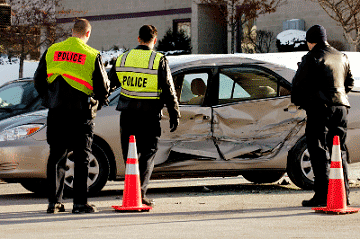- Home
- Loss Control
- Loss Control Insights
- Roadside Safety for First Responders (Updated April 2021)
Most people understand that firefighters, police officers and other first responders face danger as a part of their daily jobs, but few would expect drivers going about their normal business to be one of the biggest sources of that danger. Thousands of roadway responses occur every day in the United States, and at each of these scenes first responders are at risk of being hit by passing motorists.
While working near moving vehicles is always dangerous, adequate training and advance planning can reduce struck-by incidents and make roadside work safer for everyone involved.
Roadside Safety Training Topics for First Responders
Roadway incident safety training is especially important for new recruits and volunteers but should also be reinforced regularly for all first responders. What you cover will be unique to your agency’s function, but a recent webinar on highway safety for first responders, presented by EMC partner Lexipol in conjunction with the Emergency Responder Safety Institute, highlights some key steps.
Below are some roadside safety topics that are generally included in first responders training.
Hazard Awareness—
First responders often underestimate the danger of working near traffic. Inform your team on how often first responders are hit by vehicles and include information about “D drivers” (drunk, drugged, drowsy, disgruntled, distracted) to make sure your staff understands the threat.Practices and Procedures—
To make sure everyone is on the same page, document your Standard Operating Guidelines (SOGs) for responding to roadside incidents.Scene Size-Up and Reports—
In the event of a roadside incident, the first arriving unit on the scene should report traffic-related details, such as which lanes of the roadway are affected and which lanes they will block off.Communications and Terminology—
If you have multi-lane highways in your jurisdiction, explaining the location of an incident can be difficult. Create a standard lane numbering system to clear up potential confusion.Emergency Vehicle Positioning—
How will you protect your scene and all the first responders, victims and property inside of it? Discuss ways to shield the scene without creating additional issues for other motorists.Personal Protective Equipment—
OSHA requires all emergency response personnel to wear high-visibility vests while operating at roadway incidents, unless they are actively exposed to flames or heat (i.e. fighting a fire) or are actively involved in a hazardous materials incident.Temporary Traffic Control and Devices—
Explain how traffic control devices such as cones, signs and flares should be deployed to give motorists advance warning or your operations. Make sure you cover acceptable processes for putting them out and taking them down safely.
Who Should be Involved in Roadside Safety Planning?
An important step in making roadside operations safer is getting all local agencies together to plan. Meet at least once a quarter and invite representatives from all agencies that you expect to be involved with roadway incidents, such as:
- 911 dispatchers
- DOT and public works
- EMS
- Fire and rescue
- Law enforcement
- Medical examiner
- Safety service patrols (“highway helpers”)
- Towing and recovery
Planning ahead can help eliminate the command and control confusion that leaves first responders vulnerable to traffic. Use your time together to create an organized approach to roadway responses and consider incorporating the following exercises into your meeting:
- Critique recent incidents to evaluate response and discuss improvements
- Look for conflicts between agency SOPs/SOGs that might decrease safety during an incident
- Review common terminology
- Discuss incident command systems and/or unified command
- Talk about apparatus and vehicle placement
- Discuss Temporary traffic controls
- Review personal protective equipment
- Plan multi-discipline training opportunities
- Establish and reinforce relationships
Emergency Traffic Control and Scene Management Guidelines
Traffic control is an essential part of incident responses. Having a planned and coordinated process to respond to and clear traffic incidents and restore traffic flow will help keep first responders and other drivers safe.
Blocking and Signage—
Position first arriving vehicles in a way that protects the scene—this is called “blocking”. The specifics of your blocking will vary, depending on what vehicles are responding and what the call is for. The placement of a patrol car on a traffic stop will be different than an EMS unit responding to a medical assist call. Because of their size and visibility, many incidents use fire apparatus as a block. Additionally, parking blocking vehicles at an angle can help motorists see that the vehicle is stopped and not moving.By blocking the lane of travel upstream of the incident, you can guide moving traffic away from the scene. You’ll also want to make sure you provide adequate advance warning to motorists that the traffic pattern is changing ahead. Advance warning techniques are not just useful on high speed highways, but also in any roadway area where you might not be easily seen by drivers.
Clear the Scene Quickly—
Ideally, you should attempt to get everyone and everything away from the roadway as quickly as possible to minimize disruption to traffic and the chances of a secondary incident. Consider the following strategies to help or incentivize your staff to clear the scene quickly.- Utilize Move It or Work It a systematic decision-making model for deciding if an incident can be moved out of travel lanes to a safer area
- Encourage faster removal of stranded vehicles through TRIP (towing and recovery incentive programs)
- Work tasks concurrently whenever possible to shorten time on-scene
- Use the unified command and incident action plans you created with your partner agencies
- Release any units that aren’t needed for work or scene safety
Learn More
Get in touch
Need help? We’re here for you! Whether you have questions or need personalized assistance, your local office is ready to support you.
Loss Control Insights
Stay informed with the latest news and receive actionable safety tips, all carefully curated by our team of experts.
